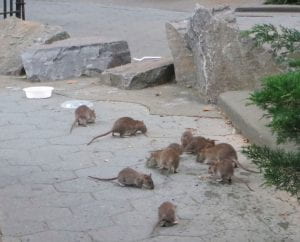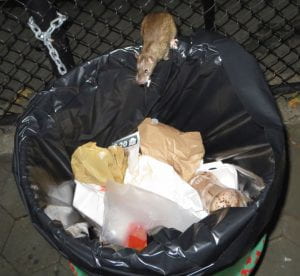As an entomologist that specializes in pest management, the Coronavirus outbreak has resulted in some unique concerns. Recent attention has focused on how human isolation affects rodent populations, but other challenges await. Fear of food shortages led residents to stock up on items like flour, rice and pasta. With grocery store shelves restocked and a food shortage not realized, this hoarding behavior creates the perfect storm for pantry pest problems. Without proper storage in tightly sealed containers, these insects can infest forgotten items and result in ironic food waste, created by fear of a food shortage.

But for now, let us turn to the issue at hand – rats, and specifically urban rats. Across the country, as people retreated to their homes to isolate, once cryptic rats emerged to forage in broad daylight. Observers noted rats fighting over food, cannibalizing each other (muricide) and their offspring (infanticide), and moving to new locations. Sensational headlines talk of angry, mutant super rats, but what is really happening?

Let’s take a step back. Before humans were isolating, abundant food waste from restaurants, trash cans in parks, subways and housing areas provided nourishment to sustain large urban rat populations. Seemingly overnight, however, those predictable resources disappeared. The outcome is a struggle for survival and a thinning of the herd as large populations are challenged by limited resources. This is a case study on tenets of the Theory of Natural Selection, but is it enough to change the evolutionary trajectory of rats to create super rats? Definitely not. Modern rats are opportunistic animals that are already adapted to deal with food shortages. Movement to new areas and cannibalism are known rat behaviors, made obvious on a large scale during this pandemic. While it may feel longer, people have only been isolating for about two months in the US, enough time for one to two rat generations. Meanwhile, rat evolution has occurred over thousands of generations to create the “diabolically clever” animal we face today.
The truly important question we should ask ourselves is, how should we respond? The pandemic has provided an opportunity for people to see exactly how our behaviors and our management of food waste affects rodent populations. Indeed, we are the cause of our rodent problems. What steps can we take to manage rodent populations today and into the future?
To start, now is the ideal time for municipalities and pest professionals to work together to reduce rodent populations. Rats are stressed for food, making them more likely to feed on rodenticide baits and interact with baited traps. Efforts should be coordinated to the scale of the rodent population. For example, in New York City, data from the Rat Information Portal can guide management and direct adequate attention to areas with high rat pressure – rather than waste resources elsewhere. Furthermore, efforts must consider the management unit that will impact the rodent population. Whereas contracted pest management companies may service an individual store front or building, the rodent problem may span an entire block between nesting and feeding sites.
Now is also the time for building owners and managers to assess their facilities for pest entry points, and to use appropriate materials to seal openings. Not all materials are rodent-proof, and guidance on selecting the appropriate materials can be found on the Scientific Coalition on Pest Exclusion’s website. Keeping pests out of facilities is the best approach to minimizing exposure to rodent-borne disease and the physical damage that rodents cause by gnawing. The bigger challenge is to devise long-term strategies that will reduce rodent access to food waste. If, upon lifting social distancing restrictions we return to “business as usual,” with trash bags left on street corners overnight, we will see a rapid return of rat populations and lose any ground we gained in the war on vermin. Certainly pest proof refuse containers would help, but not all solutions require an expense. Changes in the pickup schedule for food waste, the timing of when trash is placed on the street, how and where refuse is stored before disposal, and other considerations can be tweaked to minimize food availability for rats.
The bigger challenge is to devise long-term strategies that will reduce rodent access to food waste. If, upon lifting social distancing restrictions we return to “business as usual,” with trash bags left on street corners overnight, we will see a rapid return of rat populations and lose any ground we gained in the war on vermin. Certainly pest proof refuse containers would help, but not all solutions require an expense. Changes in the pickup schedule for food waste, the timing of when trash is placed on the street, how and where refuse is stored before disposal, and other considerations can be tweaked to minimize food availability for rats.
The Coronavirus pandemic will not create super rats, but can help us in the fight to reduce their populations and impacts – if we choose to do so.
